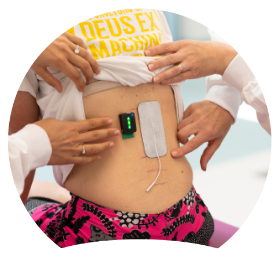A recent study has shown for the first time that transcutaneous spinal cord stimulation, also known as neurostimulation, can be used successfully in people while they are still recovering in hospital, writes Tom Elphick, SpinalCure Community Ambassador.
Neurostimulation is one of the most exciting areas of research in improving outcomes for people with spinal cord injuries, and SpinalCure is supporting a clinical trial with this technology in Australia. The study, published in March this year, suggests it can be used widely in the recovery process from a spinal cord injury.
The researchers, in Atlanta in the U.S., used neurostimulation in people who had been injured within the past six months and were still undergoing in-patient rehabilitation.
“The study is important,” said Duncan Wallace, SpinalCure Executive Director, “Because it demonstrates that the technology is safe and effective in people with spinal cord injury in early recovery and enhances their rehabilitation.”
The study also shows that neurostimulation with regular therapy increases the distance that people can walk in a timed experiment.
Somewhat surprisingly, the stimulation and regular therapy didn’t improve spasticity which has been reported in other studies using transcutaneous spinal cord stimulation.
How does this study add to our knowledge?
This study adds to our knowledge about using neurostimulation in people with spinal cord injury by:
- Showing that it is also safe in people shortly after their injuries
- Helping us understand how the stimulation works in people who are still undergoing ‘natural recovery’, a term used to describe a period of about two years where the spinal cord recovers by itself.
- Finally, the great news about this study is that it shows improvements with just 2 weeks of stimulation, which is much shorter than what other studies have used. If improvements occur after only 2 weeks of therapy, then hopefully 6 or even 12 weeks of therapy will show even greater improvements. More studies need to be done to determine what type of improvements people make and how much they improve by, but this is a great start.
What is SpinalCure doing with neurostimulation?
The final goal of SpinalCure’s support of Australian studies for neurostimulation is to see it be used in rehabilitation and exercise programs such as NeuroMoves as a regular therapy, and this study is further confirmation of treatment’s effectiveness.
Further research is needed, and we are currently running a clinical trial at NeuRA in Sydney, with plans to widen this trial to include more spinal injury types and bodily functions.
What is neurostimulation?
Neurostimulation is a technique that delivers stimulation to the spinal cord by pads that are placed on the skin over the lower spine, when delivered externally. Also known as transcutaneous spinal cord stimulation, it aims to reactivate the walking pathways in the spinal cord and improve walking ability.
Find out more about our trial.
More information: read the study Combined Transcutaneous Spinal Stimulation and Locomotor Training to Improve Walking Function and Reduce Spasticity in Subacute Spinal Cord Injury: A Randomized Study of Clinical Feasibility and Efficacy, https://www.mdpi.com/2077-0383/10/6/1167/htm
References
Burt, A. A. (2004). (iii) The epidemiology, natural history and prognosis of spinal cord injury. Current Orthopaedics, 18(1), 26-32.

